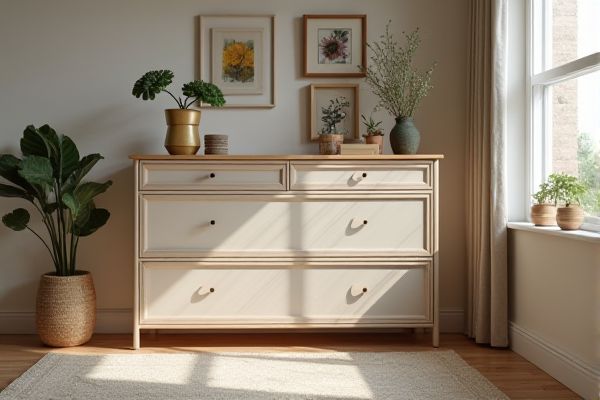
Drawer units offer organized, easily accessible compartments ideal for storing small tools or office supplies, while bin storage excels in holding larger, bulkier items with quick retrieval through open or labeled bins. Explore the full article to discover which storage solution best fits Your space and organizational needs.
Table of Comparison
| Feature | Drawer Units | Bin Storage |
|---|---|---|
| Storage Type | Pull-out drawers for organized items | Open or closed bins for flexible storage |
| Accessibility | Easy access with sliding drawers | Quick access to bins, but may require lifting |
| Organization | Ideal for small parts, tools, and documents | Better for bulkier items or mixed materials |
| Space Efficiency | Compact, stackable drawer units save space | Bins can be stacked but may take more room |
| Durability | Typically robust with metal or plastic construction | Varies by bin material; plastic bins are common |
| Cost | Generally higher due to built-in drawer mechanisms | Usually lower cost with simple design |
| Ideal Use Cases | Workshops, offices, parts storage requiring order | Warehouses, general storage, loose items |
Introduction to Drawer Units and Bin Storage
Drawer units provide organized, compartmentalized storage ideal for small items requiring easy access and visibility, while bin storage offers versatile, stackable solutions suitable for bulkier or irregularly shaped materials. Choosing between drawer units and bin storage depends on your space constraints, item size, and frequency of use. Maximizing efficiency in your storage setup involves matching the system to your specific organizational needs.
Key Differences Between Drawer Units and Bin Storage
Drawer units offer organized, enclosed compartments ideal for protecting items from dust and damage, while bin storage provides easy access and visibility for frequently used materials. Drawer units are better suited for tasks requiring systematic categorization and security, whereas bin storage excels in quick retrieval and bulk storage. Your choice depends on whether you prioritize protection and order or accessibility and capacity for your workspace.
Space Efficiency: Drawer Units vs Bin Storage
Drawer units maximize space efficiency by utilizing vertical storage and compartmentalized sections, allowing organized access to small items and tools without wasted space. Bin storage offers flexible stacking and easy visibility for bulkier items but can lead to underutilized gaps and less organized vertical use. Compared to bin storage, drawer units optimize floor footprint and improve retrieval speed in tight workspaces or workshops.
Accessibility and Organization
Drawer units provide superior accessibility by allowing you to slide open compartments for easy visibility and retrieval of items, making organization straightforward and efficient. Bin storage offers flexible sorting options with transparent or labeled containers, facilitating quick identification but may require additional stack management to maintain order. Choosing between them depends on your need for immediate access versus customizable storage arrangements.
Durability and Material Quality Comparison
Drawer units typically feature robust materials like metal or heavy-duty plastic, offering superior durability for long-term use compared to bin storage, which often utilizes lighter plastic prone to wear and cracking. High-quality drawer units are engineered with reinforced frames and smooth gliding mechanisms, ensuring consistent performance under frequent access. Bin storage, while convenient and versatile, generally lacks the structural integrity of drawer units, making it less ideal for heavy or frequent usage.
Ideal Uses for Drawer Units
Drawer units are ideal for organizing smaller tools, office supplies, and craft materials that require easy access and clear categorization. Their compact design enhances workspace efficiency by keeping your items neatly separated and visible, minimizing clutter. Choose drawer units when you need systematic storage solutions that prioritize accessibility and organization in tight spaces.
Best Applications for Bin Storage
Bin storage excels in environments requiring rapid access and high visibility of small parts, such as assembly lines and warehouse picking stations. Its modular design allows customization to organize hardware, components, or office supplies efficiently, reducing downtime and improving workflow. Ideal for environments with frequent inventory turnover, bin storage supports streamlined restocking and easy identification of contents, enhancing overall storage management.
Cost Analysis: Drawer Units vs Bin Storage
Drawer units generally have a higher upfront cost compared to bin storage due to their durable materials and built-in organizational features. Bin storage offers a more cost-effective solution for bulk or irregularly shaped items, with lower initial investment and flexibility. Long-term maintenance and replacement costs tend to be lower for bin storage, while drawer units may require occasional repairs or part replacements to maintain functionality.
Maintenance and Longevity
Drawer units typically require regular cleaning of rails and tracks to ensure smooth operation, while bin storage demands frequent inspection for cracks or damage to maintain durability. Proper maintenance of drawer units can extend their lifespan by preventing jams and structural wear, whereas bin storage longevity depends on using high-quality materials resistant to impact and environmental factors. Choosing the right storage solution for your needs impacts maintenance efforts and overall durability, ensuring your investment lasts longer.
Choosing the Right Storage Solution for Your Needs
Selecting between drawer units and bin storage depends on your space requirements and the types of items you need to organize. Drawer units offer easy access and better organization for smaller items, while bin storage provides flexibility for bulkier or larger objects. Your choice should optimize accessibility, space efficiency, and item protection based on how frequently you use your belongings.
 homyna.com
homyna.com